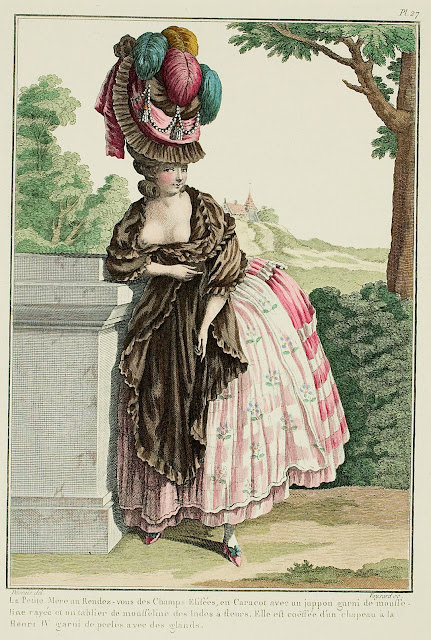Galerie des Modes, 11e Cahier, 3e Figure
Little Mother at a Meeting in the Champs Elysées, in a Caraco with a petticoat trimmed with striped muslin and a flowered Indian muslin apron. She is coiffed with a Henri IV hat trimmed with pearls with tassels. (1778)
The costume this Print offers breathes a tone of voluptuousness which it is difficult to defend; so it is selected of the beauties that Solomon called proper quivers to receive all sorts of arrows.
This costume is composed of four principal pieces, which are described here.
1. On a chien couchant hairstyle, with two stylish falling curls, is placed a Henri IV hat, trimmed with all that belongs with that style: the crown, the brims, and the panache are black.
2. Very short Summer Caraco, leaving the entire chest uncovered; the caraco is trimmed with gauze in large stripes across it.
3. Petticoat covered for two-thirds of its height with a volant of Indian muslin with large stripes, similar to the trimming.
It is caracos that cause petticoats to be surrounded with vast volants: they once had demi-volants, or a front flounce; there was even a time that one wore a false petticoat under gowns, called for this reason an apron, or a trompette.
The first volant was only a rather narrow band attached to the bottom of the petticoat at the two ends. It only then captivated the upper edge, and for a long time it stayed in that state of modesty. But caracos having lost their length, one is advised to fill the void they leave on the petticoat by making the volant higher. The fashion of polonaises and pulled-up gowns achieved the extent of the empire of volants: of all the trim, they became an essential part of dress, and they are the most agreeable and varied trim.
Caracos and polonaises also require aprons; they ordinarily fill the whole space which one finds between the waist and the volant; sometimes, as in the Print, they cover the entire front of the petticoat. The former are trimmed around their edges, but the others have no trimming unless the petticoat does. Indian muslin, linen, and filet lace, plain or embroidered, are the stuff which have the exclusive privilege of composing them.
4. The mantelet seems, at first glance, to remove a part of the grace of the elegant costume, but this is not the effect in this case. This part of dress, with regard to the parure, may be compared to shadow in a painting: that which produces illusion is very removed from destroying it.
It is therefore with reason that this Beauty is enveloped in a vast mantelet à coulisse with flared points; with it, she has nothing to fear about her very beautiful chest staying unnoticed; the flared points are very favorable to the plump waist, which needs to be hidden under a vast but light drapery.







Oooh! That hat, I love it!
ReplyDelete-Emily
Wow! That was a surprise! Interesting that it's a "caraco" which exposes the chest.
ReplyDelete